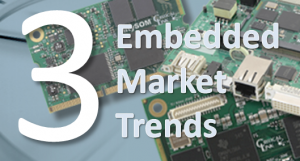Last week, we posted an article on the ARM Connected Community site. This is an interesting and useful information-sharing forum for anyone working with – or just plain interested in – ARM. There are a number of “subdivisions” dedicated to specific areas, from ARM processors to SOC to wearables.
Our post wasn’t ARM-specific, but was rather our take on the trends we’re seeing in the embedded market (including ARM, of course). Anyway, I thought you’d be interested in what we had to say, so we’re running the article here, as well.
 We at Critical Link have worked on some pretty complex applications for nearly 20 years, and so we’re exposed in real time to trends in the embedded market. Our work creating System-on-Modules (SoMs), custom baseboards, and complete ground-up solutions for various markets has helped illuminate three key trends we think are transforming the embedded computing market.
We at Critical Link have worked on some pretty complex applications for nearly 20 years, and so we’re exposed in real time to trends in the embedded market. Our work creating System-on-Modules (SoMs), custom baseboards, and complete ground-up solutions for various markets has helped illuminate three key trends we think are transforming the embedded computing market.
First is the increasing demand for an engaging user interface. Traditionally, the higher end the application, the less focus on the UI. Blue, green, or amber screen, seven segment or text display, command line or simple menu picks – all were fine. But now that everyone has gotten used to what’s possible with cellular telephone interfaces and apps, customers are demanding an improved user experience in other applications.
Whether they’re building something new from scratch or refreshing an existing product with a sexier display, embedded developers are paying a lot of attention to the interface. They are looking at options for integrating a color LCD display and Ethernet or WiFi capability. So although a product itself may not require an ARM core, the final architecture will require an ARM-based solution that runs embedded Linux because it enables the desired UI improvements and connectivity.
A second important trend for embedded designers is the combination of rising technology complexity and the rate of integration. At Critical Link, our products have focused on combining FPGAs with either DSPs or ARM technologies. Traditionally these have been discrete solutions with the device connectivity at the board level. But with the new System on Chip (SoC) architectures where the FPGA and ARM are contained in the same die, companies often don’t have the experience to get these two technologies to work together efficiently and effectively. The software team doesn’t always understand the FPGA, and the hardware developers struggle with software in the ARM. Neither can do without the other, and as a result talented engineers who are proficient in both disciplines are in high demand. (Given that many of our customers don’t have those resources available, our approach has been to provide examples and a full setup to help customers get over their learning curve.)
In conjunction with this comes the third key trend: We continue to see companies narrowing focus to their true core competencies. They see value in leveraging off-the-shelf boards and focus on their unique expertise and developing the domain specific performance that distinguishes the product from competitors. In fact, we’ve seen a drastic shift away from the belief that making it all in house saves money. To do more with a smaller engineering team, companies who would never consider working with off-the-shelf hardware are now recognizing it as a key piece of their get-to-market strategy, and ultimately faster ROI.
Even after 20 years, we continue to be on the lookout for what’s next, but for now these are some of the trends we’re seeing unfold in real time, each of which are likely to continue driving innovation in the embedded market.
